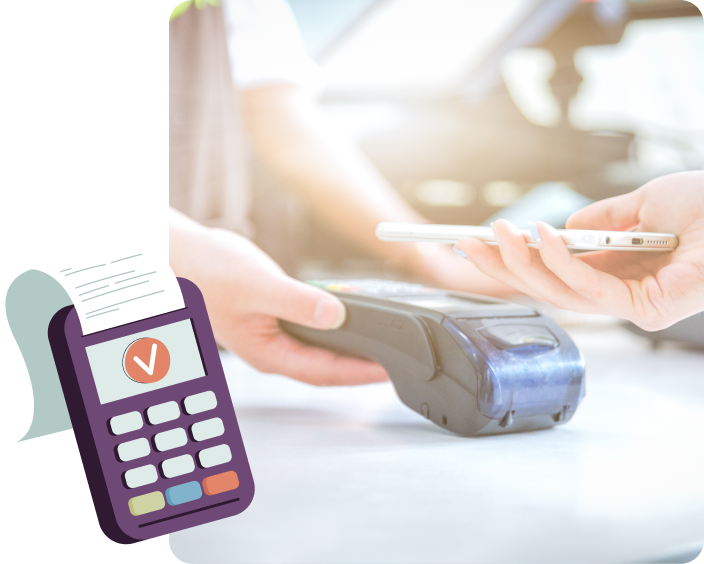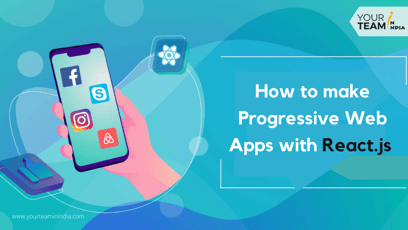Hire Progressive Web App Developers
Building lighting fast web apps with the look & feel like native apps. Contact us now & build your reliable team of top pwa developers at reasonable cost.
- Dedicated progressive web app developers.
- Expertise with HTML, CSS, and JavaScript.
- Easy onboarding process.
- 2X Faster Project Delivery.
-
16+
Years
Experience -
200+
Certified
Developers -
1000+
Projects
Delivered
Build a Remote Team Now!
Hire the best developers in India with a free trial
100% Privacy Guaranteed
Progressive Web App Development Services
Our progressive web app developers have enabled several businesses to reach their customers across multiple devices and platforms with an engaging mobile like web app. You can opt for any of our progressive web development services to enhance the digital experience of your business.
Responsive PWA Services
Uninterrupted connectivity and compatibility with multiple devices and platforms. With top PWA developers supporting us throughout, we take pride in building robust and highly responsive apps that promote better business.
PWA Customization
Leverage our robust progressive web app development services and build highly customized web applications that work seamlessly across multiple platforms and deliver excellent user experience just like native apps.
Plug-in Development
Having the required expertise, our PWA developers can develop plugins from scratch or integrate the third-party plugins to extend the app functionality and boost the digital presence of your business.
Progressive App Design
Our PWA experts focus on designing visually stunning progressive applications for your business that cultivate new opportunities to deliver seamless user experience on cross-platforms.
Secure Data Migration
PWA developers at YTII follow a structured approach for data migration considering both data and value before migration. We create feature-rich, highly functional apps that are an apt blend of native and browser applications.
App Shell Model
Our progressive web app developers utilize this architecture to build a PWA that loads on user’s screens instantly. It allows us to develop reliable performing apps that are fast, and enhances user engagement.
PWA Technology Stack
Your Team in India has a robust team of progressive web app developers, that render their know-how, knowledge, and skills in all extents of web app development.

HTML

CSS

JavaScript

React

Angular

Node.js
Why Hire Dedicated PWA Developer From YTII?
Increase conversion and delight your users with next-gen applications built by our talented team of PWA developers. Our dedicated PWA programmers and engineers are ready to successfully deploy robust web app solutions for your business.
Hassle-Free Project Management
YTII’s talented PWA developers proficiently deal with complex problems that act as a hindrance in the development process. They have expertise in managing such hindrances, allowing better app development.
Experienced and Reliable
Our highly reliable and dedicated PWA App development process results in some interactive and intelligent apps for your business. We deliver seamless PWA development services utilizing the skills and expertise of our web developers.
100% Transparency
We rely on a 100% transparent development process. From the reporting system to project completion and the final development process, everything is transparent when you are working with offshore developers at YTII.
Fulfilling Customized Needs
Customized plans are always available for all valued businesses. We have personalized pricing and plans for different business needs. Our PWA developers are available on an hourly, monthly, part-time, and full-time basis. Hire as per your business needs!
No-Cost Estimate
Want to turn your basic web app into progressive? Share your requirements with our PWA developers and get a no-cost estimate within a few hours of the project sharing process. We don’t charge anything extra, and we don’t believe in delayed services.
Your Project Secrecy, Our Priority!
We prioritize every business requirement. We truly value your idea and keep it safe with our experts. Before we collaborate for the development tasks, our team will utilize NDA for developing a trustworthy relationship and better apps.
Engagement Models to Hire Progressive Web Apps Developers
Hiring developers at YTII is simple. Comprehending your project’s need, we have designed various engagement models for reaching your dedicated development team.
Monthly Based
Hire offshore staff for up to 160 hours a month
Manage team using your own methodologies
Get real-time updates on project development
Monthly billing cycles
Hourly Based
Pay for the work done in hours
Add or revoke hours based on requirements
Communicate via your own preferred channels
Real-time updates via timesheet
Fixed-Cost Projects
Fix the project cost before hiring remote developers
Hire developers on a long-term basis
Extend your existing team & reduce time to market
Flexibility to change scope at nominal charges
Top Industries We Serve
Our dedicated developers have experience working with diverse industries, ranging from banking, finance, eCommerce, healthcare, education, and more.

eCommerce &Shopping

On-Demand Solutions

Transportation &Logistics

FinTech

Education &Learning

Media & Entertainment

Food & Drinks

Health & Fitness

E-Scooter

Lifestyle
Our Success Stories
We assist both new and emerging startups in developing MVPs, forming teams, and gaining access to cutting-edge technologies. From application creation to modernization and maintenance, our 360° enterprise solutions cover it all.

GoHire
Leading Application Tracking System (ATS) in Europe
Project Scope- GoHire wanted to build a robust hiring solution for SMEs globally that allowed them to hire the right candidates for their organization easily and quickly.
Solution Delivered- After a detailed discussion with clients regarding the project requirements, YTII recommended the Product Engineering Model of the Offshore Development Center
Read Full Story

Dorey Finance
Actuarial Technology (AcTech) company in Guernsey
Project Scope – The client wanted to upgrade its financial tool to improve user experience, reduce operational costs, and address performance issues caused by outdated technology.
Solution Delivered – We helped them deploy a senior developer within two weeks, upgraded tech stack, and optimized performance and overall operational efficiency.
Read Full Story

Finding You
Robust Dating App in Luxembourg
Project Scope – Finding You wanted to create a dating app combining astrology and psychometric analysis and build a budget-friendly, user-friendly matching engine.
Solution Delivered – The app was built with advanced astrological charting and filtering features, while marketing efforts helped expand the user base globally.
Read Full Story

Gettrx
Leading Payment Gateway in US
Project Scope – Gettrx sought a dependable team of experienced IT resources that took care of end-to-end development and management of the solution while ensuring code standards were being met at all time.
Solution Delivered – Your Team" in India deployed highly skilled software engineers with 6+ years of experience in handling complex product development in an agile work model
Read Full Story

Plena Data
Financial Process Automation (USA)
Project Scope – The client sought an offshore software development company that could provide them with the right talent to build premium-quality bots in a quick turnaround time while ensuring complete IP protection.
Solution Delivered – With a team of highly skilled professionals working on developing RPA solutions, the client was able to deliver high-quality bots to their customers quickly and efficiently.
Read Full Story
Frequently Asked Questions
It is a type of application software, which is built utilizing common web technologies, including JavaScript, CSS, and HTML. Progressive Web App works on all platforms and is built with modern APIs that help in delivering reliability, capability, and robustness in the apps, utilizing a single codebase.
There are 3 pre-requisites when migrating to a progressive web app:
- Android device running Chrome 52 or above
- Understanding of Chrome DevTools and Git
- Text editor and sample code
1) Load the URL
2) Open your website on the mobile
3) Add Modern Head Tags
4) Add a service worker
5) Your site will work offline now
Building a progressive web app costs between $6000 and $20000. Most of the developers prefer PWA these days. The reason is the cost-effectiveness and the rich-features that help in building highly reliable apps for a growing business.
Yes, PWA can access some (not all) features, and the camera is one such feature that can be accessed using the Progressive web app.
The main difference between a native app and a PWA app is that progressive web app functions in a browser. Hence, there is no requirement to download it. PWA allows users to stay updated, no matter how poor the internet connection is.
Clients’ Testimonials: Establishing Digital Trust
We love partnering with new clientele! YTII has more than 3000 satisfied clients who continuously support us via their feedback, more projects, and suggestions.

Using offshore development services by Your Team in India, we hired highly skilled developers who helped us build a robust and scalable candidate automation solution. Their hands-on project management and seamless communication never made us realize we were working with an offshore partner.

We were highly impressed by the hands-on approach shown by Your Team in India. After understanding our requirements, they quickly arranged interviews with their talented developers. Our offshore team was ready and working on the project within a few days. We worked with highly-talented and experienced developers who helped us improve the product while ensuring they met all delivery milestones.

We could not have asked for a better partner than Your Team in India to manage our product. Our offshore development team of experts always shares insights on improving our solution.

Your Team in India is genuinely a partner you can count on. With over 1.5 years of experience working with them, I have witnessed their unwavering commitment to understanding their clients' passions and delivering exceptional results. I highly recommend them as a reliable and dedicated outsourcing partner.

Amit and his team are great. They were able to complete the requested job faster than I had expected and went above and beyond to identify things I was unaware of. They went on to make these other small corrections without additional cost during the updates. I have hired this team before and will hire them again, as I am reminded of their high level of professionalism, integrity and ability... Thanks Amit !!.

Your Team in India has been our partner since the start of TeleCloud’s automation journey. Their in-depth consulting capabilities, easy to comprehend plans and a ground up, practical implementation approach helped us automate multiple processes within the organization. At present, YTII has implemented more than 50+ bots that sort various day to day accounting, book keeping and compliance related processes for TeleCloud. We believe our drive for automation has just begun and will continue till we enable a bot for every process that can be automated.

Your Team In India's pool of talent is incredibly efficient. They gave us unabridged access to the best full stack developers, enabling us to build an amazing product- one that’s best to our capabilities.
Our Blog
Read on the topics that matter most to you through our comprehensive research articles & informative blogs.

How to Make Progressive Web Apps with React.js
Ready To Connect?
Choose your developers from our extensive talent pool and start your 7-days Risk-free trial. We provide transparent hiring of teams so that you can choose the right developer based on your project requirement.

